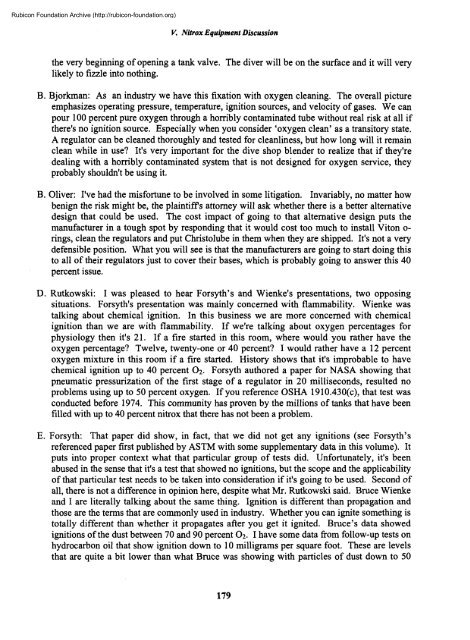Nitrox workshop dings - Divers Alert Network
Nitrox workshop dings - Divers Alert Network
Nitrox workshop dings - Divers Alert Network
You also want an ePaper? Increase the reach of your titles
YUMPU automatically turns print PDFs into web optimized ePapers that Google loves.
Rubicon Foundation Archive (http://rubicon-foundation.org)V. <strong>Nitrox</strong> Equipment Discussionthe very beginning of opening a tank valve. The diver will be on the surface and it will verylikely to fizzle into nothing.B. Bjorkman: As an industry we have this fixation with oxygen cleaning. The overall pictureemphasizes operating pressure, temperature, ignition sources, and velocity of gases. We canpour 100 percent pure oxygen through a horribly contaminated tube without real risk at all ifthere's no ignition source. Especially when you consider 'oxygen clean' as a transitory state.A regulator can be cleaned thoroughly and tested for cleanliness, but how long will it remainclean while in use? It's very important for the dive shop blender to realize that if they'redealing with a horribly contaminated system that is not designed for oxygen service, theyprobably shouldn't be using it.B. Oliver: I've had the misfortune to be involved in some litigation. Invariably, no matter howbenign the risk might be, the plaintiffs attorney will ask whether there is a better alternativedesign that could be used. The cost impact of going to that alternative design puts themanufacturer in a tough spot by responding that it would cost too much to install Viton o-rings, clean the regulators and put Christolube in them when they are shipped. It's not a verydefensible position. What you will see is that the manufacturers are going to start doing thisto all of their regulators just to cover their bases, which is probably going to answer this 40percent issue.D. Rutkowski: I was pleased to hear Forsyth's and Wienke's presentations, two opposingsituations. Forsyth's presentation was mainly concerned with flammability. Wienke wastalking about chemical ignition. In this business we are more concerned with chemicalignition than we are with flammability. If we're talking about oxygen percentages forphysiology then it's 21. If a fire started in this room, where would you rather have theoxygen percentage? Twelve, twenty-one or 40 percent? I would rather have a 12 percentoxygen mixture in this room if a fire started. History shows that it's improbable to havechemical ignition up to 40 percent O2. Forsyth authored a paper for NASA showing thatpneumatic pressurization of the first stage of a regulator in 20 milliseconds, resulted noproblems using up to 50 percent oxygen. If you reference OSHA 1910.430(c), that test wasconducted before 1974. This community has proven by the millions of tanks that have beenfilled with up to 40 percent nitrox that there has not been a problem.E. Forsyth: That paper did show, in fact, that we did not get any ignitions (see Forsyth'sreferenced paper first published by ASTM with some supplementary data in this volume). Itputs into proper context what that particular group of tests did. Unfortunately, it's beenabused in the sense that it's a test that showed no ignitions, but the scope and the applicabilityof that particular test needs to be taken into consideration if it's going to be used. Second ofall, there is not a difference in opinion here, despite what Mr. Rutkowski said. Bruce Wienkeand I are literally talking about the same thing. Ignition is different than propagation andthose are the terms that are commonly used in industry. Whether you can ignite something istotally different than whether it propagates after you get it ignited. Bruce's data showedignitions of the dust between 70 and 90 percent O2. I have some data from follow-up tests onhydrocarbon oil that show ignition down to 10 milligrams per square foot. These are levelsthat are quite a bit lower than what Bruce was showing with particles of dust down to 50179
















